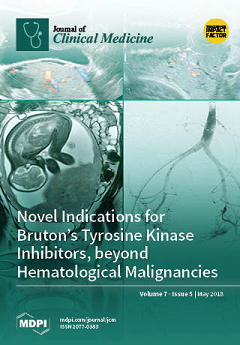The prognosis of anaplastic (ATC) and poorly differentiated thyroid cancer (PDTC) is poor, due to their radioiodine refractoriness (RAI-R), high metastatic potential and current lack of effective treatment strategies. We aimed to examine the efficacy of the tyrosine kinase inhibitors (TKIs) sorafenib and selumetinib and the histone deacetylase inhibitor (HDACI) panobinostat in patient-derived tumor tissue (PDTT) of ATCs/PDTCs, the expression of sodium iodide symporter (
NIS) and radioiodine up-take (RAI-U). High Mobility Group AT-Hook 2 (
HMGA2) and associated miRNAs expression was correlated with the clinical course of the patients. Inhibitory effects of panobinostat, sorafenib and selumetinib were measured by real time cell analyser xCELLigence in five PDTTs and human foreskin fibroblasts (HF) used as control. Expression of
NIS,
HMGA2 and associated miRNAs hsa-let-7f-5p, hsa-let-7b-5p, hsa-miR-146b-5p and hsa-miR-146b-3p was performed by RT-qPCR and Western blot. RAI-U was performed by Gamma Counter with I-131. Panobinostat showed the strongest cytotoxic effect (10 nM) in all PDTTs and HF and caused a significant over-expression of
NIS transcript. TKIs were able to up-regulate
NIS transcript in patient 5 and in HF. RAI-U was up-regulated after 24 h of treatment with TKIs and panobinostat in all PDTT and HF, except in patient 5. Selumetinib caused a significant suppression of
HMGA2 in PDTT 1, 2, 4, 5 and HF; whereas sorafenib caused no change of
HMGA2 expression. Panobinostat suppressed significantly
HMGA2 in PDTT 2, 4 and HF. The expression of miRNAs hsa-let-7f-5p, has-let-7b-5p hsa-miR-146b-5p and hsa-miR-146b-3p was modulated heterogeneously.
NIS protein level was over-expressed in three PDTTs (patients 1, 3 and 4) after 24 h of treatment with selumetinib, sorafenib and in particular with panobinostat. HF showed a stable
NIS protein level after treatment. Panobinostat showed the strongest cytotoxicity in all treated PDTTs at the lowest dosage in comparison with TKI. All three compounds were able to modulate differently
NIS,
HMGA2 and related miRNAs. These factors represent valuable markers in PDTT for new treatment strategies for patients suffering from ATC/PDTC. Thus, the establishment of PDTT could be a useful tool to test the efficacy of compounds and to develop new and individualised multimodal treatment options for PDTCs and ATCs.
Full article






